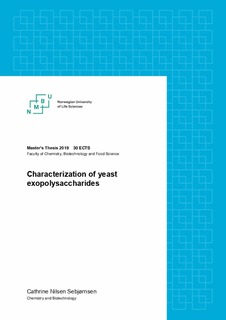| dc.contributor.advisor | Arntzen, Magnus Øverlie | |
| dc.contributor.advisor | Westereng, Bjørge | |
| dc.contributor.author | Sebjørnsen, Cathrine Nilsen | |
| dc.date.accessioned | 2019-09-25T13:47:04Z | |
| dc.date.available | 2019-09-25T13:47:04Z | |
| dc.date.issued | 2019 | |
| dc.identifier.uri | http://hdl.handle.net/11250/2618788 | |
| dc.description.abstract | In this thesis a method for quantification of the exopolysaccharides (EPS) of the yeast cell wall (YCW) has been under development. Such a method will be of interest for the research on the use of yeast in aquafeed to take advantage of the immunostimulative effect the carbohydrates in the YCW. The major carbohydrate components in the YCW are β-1,3-glucan, β-1,6-glucan, mannan oligosaccharides and chitin. In the method being developed, MicrofluidizerTM LM20 was used to the disrupt the yeast cells with shear forces. Centrifugation was then used to isolate the YCW in a carbohydrate-rich pellet and create a protein-rich supernatant. The isolated YCW was then hydrolyzed using both sulfuric acid, and specific enzymes for hydrolysis of defined bonds. Sulfuric acid hydrolysis gave the total β-glucan content. Exo-1,3-β-d-glucanase isolated from Asperillus oryzae, endo-1,3-β-d-glucanase isolated from barley, endochitinase C and chitobiase, both isolated from Serratia marcescens was used in one step to hydrolyse β-1,3- glucan and chitin into their respective monosaccharides, glucose and N-acetylglucoseamine. In another step α-mannanase and α-mannosidase was used to hydrolyze the mannan oligosaccharides. High-performance anion exchange chromatography with pulsed amperometric detection was used to detect the mono- and oligosaccharides released by hydrolysis. The amount of β-1,3- glucan found by enzymatic hydrolysis would be subtracted from the total β-glucan found by acid hydrolysis to give the amount of β-1,6-glucan. The motivation for using enzymatic hydrolysis in addition to acid hydrolysis, was to give higher yields for chitin to avoid underestimation of this components and to obtain a specific quantification of the components, including their specific linkages.
The results showed that disruption of the yeast cells by using MicrofluidizerTM LM20 did not give the clear separation into a carbohydrate-rich cell wall fraction and a protein-rich supernatant as expected, though most of the protein was determined to be in the supernatant. Even though we were able to estimate the amounts of 1,3 linked β-glucan using enzymes, the enzymatic conversion yield was low and further optimization of enzyme loadings and reaction conditions is needed to give a sufficient and reliable quantitative enzymatic hydrolysis. | nb_NO |
| dc.description.abstract | I denne oppgaven har en metode for kvantifisering av eksopolysakkaridene (EPS) av celleveggen til gjær (YCW) vært under utvikling. En slik metode vil være av interesse for forskningen p˚a bruk av gjær i fiskefor for ˚a utnytte den immunstimulerende effekten av karbohydrater i YCW. β-1,3-glukan, β-1,6-glukan, mannan oligosakkarider og kitin utgjør den største andelen av karbohydrater i YCW. I denne prosessen ble MicrofluidizerTM LM20 brukt for ˚a lysere gjærcellene med skjærkraft(shear force). Sentrifugering ble deretter utført for ˚a isolere YCW i en pellet med høyt karbohydratinnhold og en proteinrik supernatant. Den isolerte celleveggen ble s˚a hydrolysert ved ˚a bruke svovelsyre, og spesifikke enzymer for hydrolyse av definerte bindinger. Hydrolyse med svovelsyre ga det totale innholdet av β-1,6-glukan. Ekso-1,3-β-dglukanase isolert fra Asperillus oryzae, endo-1,3-β-d-glukanase isolert fra bygg, endokitinase C og kitobiase, begge isolert fra Serratia marcescens ble brukt i et steg for ˚a hydrolysere β-1,3- glukan og kitin til deres respektive monosakkaridenheter, glukose og N-acetylglukoseamin. I et annet steg ble α-mannanase og α-mannosidase brukt til ˚a hydrolysere mannan oligosakkaridene. High-performance anion exchange chromatography med pulserende amperometrisk deteksjon ble brukt til ˚a detektere mono-og oligosakkaridene frigjort ved hydrolyse. Mengden av β-1,3-glukan funnet ved enzymatisk hydrolyse ble subtrahert fra den totale β-glukan funnet ved syrehydrolyse for ˚a gi mengden av β-1,6-glukan. Motivasjonen for bruk av enzymatisk hydrolyse i tillegg til syrehydrolyse var for ˚a gi høyere grad av hydrolysering av kitin for ˚a unng˚a underestimering av denne komponenten og for ˚a oppn˚a en spesifikk kvantifisering av komponentene, inkludert deres spesifikke bindinger.
Resultatene viste at lyseringen av gjærcellene ved bruk av MicrofluidizerTM LM20 ikke førte til en tydelig separasjon til en karbohydratrik celleveggfraksjon og en proteinrik supernatant som forventet. Mesteparten av proteinet viste seg likevel ˚a være i supernatanten. Selv om vi var i stand til ˚a estimere mengden av 1,3-linket β-glukan ved bruk av enzymer, var det enzymatiske hydrolyseutbytte lite og ytterligere optimalisering av enzymdoser og reaksjonsbetingelser er nødvendig for ˚a gi en tilstrekkelig og stabil kvantitativ enzymatisk hydrolyse. | nb_NO |
| dc.language.iso | eng | nb_NO |
| dc.publisher | Norwegian University of Life Sciences, Ås | nb_NO |
| dc.rights | Attribution-NonCommercial-NoDerivatives 4.0 Internasjonal | * |
| dc.rights.uri | http://creativecommons.org/licenses/by-nc-nd/4.0/deed.no | * |
| dc.title | Characterization of yeast exopolysaccharides | nb_NO |
| dc.title.alternative | Karakterisering av exopolysakkarider i gjær | nb_NO |
| dc.type | Master thesis | nb_NO |
| dc.subject.nsi | VDP::Matematikk og Naturvitenskap: 400 | nb_NO |
| dc.description.localcode | M-KB | nb_NO |

